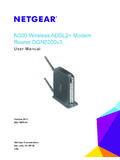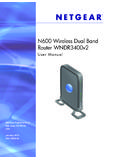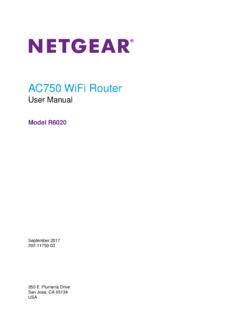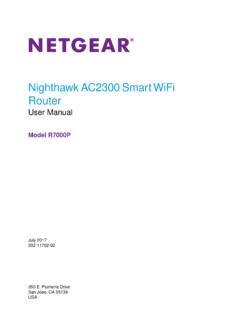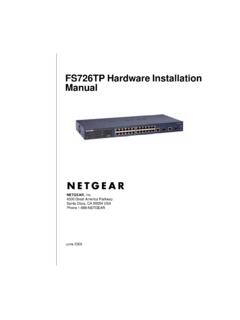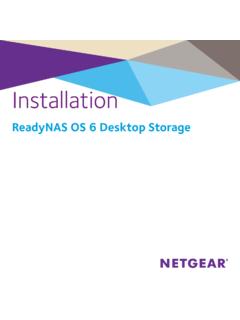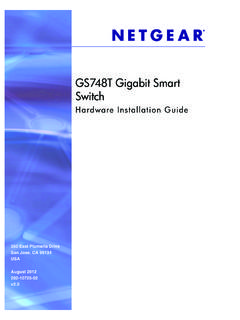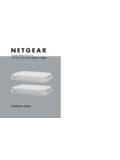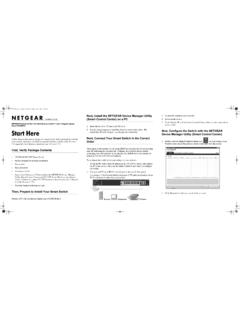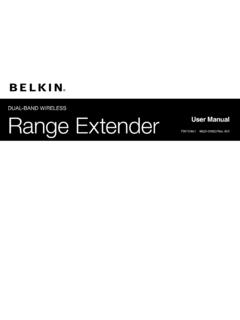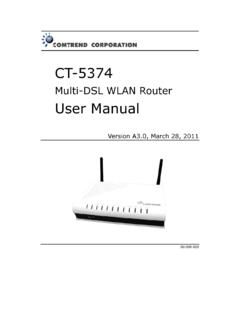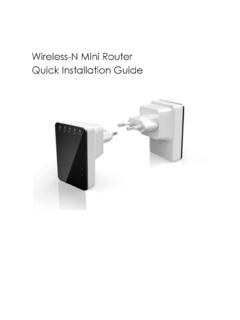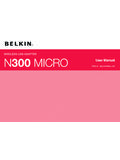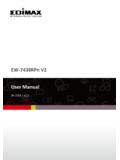Transcription of Wireless-N 150 Router Setup Manual
1 September , E. Plumeria Drive San Jose, CA 95134 USAW ireless-N 150 Router Setup Manualii 2009 by NETGEAR, Inc. All rights and the NETGEAR logo are trademarks of NETGEAR. Inc. Microsoft, Windows, and Windows NT are registered trademarks of Microsoft Corporation. Wi-Fi Protected Setup is a trademark of the Wi-Fi Alliance. Other brand and product names are registered trademarks or trademarks of their respective of ConditionsIn the interest of improving internal design, operational function, and/or reliability, NETGEAR reserves the right to make changes to the products described in this document without does not assume any liability that may occur due to the use or application of the product(s) or circuit layout(s) described 150 Router Setup Manual Getting to Know Your wireless 1 Unpacking Your New Router .
2 1 Hardware Features .. 2 Front Panel .. 2 Back Panel .. 4 Side Panel .. 4 Router Label .. 5 Positioning Your wireless Router .. 5 Installing Your wireless Router .. 6 Updating Your Router Firmware .. 7 Installing Your Router Using the Smart 8 Using the Smart Wizard .. 8 Accessing Your Router After Installation .. 10 Manually Installing Your 11 Connecting Your wireless Router .. 12 Verifying Your Connection .. 15 Setting Up Your Router for Internet Access .. 16 Configuring Your wireless 20 Specifying wireless Settings .. 20 Setting Your SSID and wireless Security Manually .. 20 Using Push 'N' Connect (WPS) to Configure Your wireless Network .. 22 Testing Basic wireless Connectivity .. 25 27 Basic Setup Checklist .. 27 Checking Basic Router Functions .. 28 Troubleshooting Login Problems.
3 30ivChecking the Internet Service Connection .. 31 Obtaining an Internet IP Address .. 31 Troubleshooting PPPoE .. 32 Troubleshooting Internet Browsing .. 33 Using the Ping Utility to Troubleshoot .. 33 Testing the Path from Your Computer to Your Router .. 33 Testing the Path from a Computer to the Internet .. 34 Technical 35 Default Configuration Settings .. 35 Restoring the Default Password and Configuration Settings .. 37 Related 38 Registration and 40 Getting to Know Your wireless Router1 Getting to Know Your wireless RouterCongratulations on your purchase of a NETGEAR high-speed wireless Router , the Wireless-N 150 Router Model you begin installing your Router , check the package contents (see Unpacking Your New Router on page 1). Become familiar with the front and back panels of your Router especially the status lights and the important information on the Router label (see Hardware Features on page 2).
4 Then, read the section on Positioning Your wireless Router on page 5 to ensure that you have selected the best location to install your Router . Unpacking Your New RouterYour product package should contain the following items: The Wireless-N 150 Router An AC power adapter (varies by region) A yellow Ethernet cable The Resource CD, which includes: The Smart Wizard Installation Assistant ( ) A PDF version of this Manual A link to the online User ManualIf any of the parts are incorrect, missing, or damaged, contact your NETGEAR dealer. Keep the carton, including the original packing materials, in case you need to return the product for link to the online User Manual is also available from the Router interface, after the Router is installed. Click Documentation on the main to Know Your wireless Router2To prepare your Router for peel off any protective film covering the sides of your your Router in a suitable area for installation (near an AC power outlet and accessible to the Ethernet cables for your wired computers).
5 Hardware FeaturesBefore you install and connect your Router , take a moment to become familiar with the front and back panels of the Router especially the status lights on the front PanelThe Router front panel, shown in Figure 1, contains status lights. (For more information on interpreting the status lights, see Verifying Your Connection on page 15 and Checking Basic Router Functions on page 28.)Figure 112345 Getting to Know Your wireless Router3 You can use the status lights to verify various Light Descriptions LabelActivityDescription1. PowerSolid AmberSolid GreenFast blink GreenSlow blink GreenOffThe Router is performing the power-on self-test power is on and the Router is software update is in is corrupted. See Checking Basic Router Functions on page 28 for instructions on restoring your Router is not being supplied to the router2.
6 Push 'N' ConnectSolid GreenBlinking GreenOffIndicates that wireless security is devices can associate with the Router within 2 WPS connection InternetSolid AmberSolid GreenBlinking GreenOffNo IP address wireless Router has acquired an Internet is being communicated with the Ethernet cable is connected to the WirelessSolid BlueBlinking BlueOffThe wireless interface is is being communicated over the wireless wireless interface is turned LAN (Ports 1 4)Solid GreenBlinking GreenSolid AmberBlinking AmberOffThe local port is connected to a 100 Mbps is being transmitted at 100 local port is connected to a 10 Mbps is being transmitted at 10 link is detected on this to Know Your wireless Router4 Back PanelThe Router back panel, shown in Figure 2, contains port from left to right, the rear panel contains the following elements:1.
7 AC power adapter outlet for connecting the power Power on/off push-button. 3. Internet/Wide Area Network (WAN) Ethernet port for connecting the Router to a cable or DSL Four Local Area Network (LAN) 10/100 Mbps Ethernet ports for connecting the Router to your local Restore factory settings button. Press for approximately 5 seconds to reset the Router to the factory default PanelThe Router side panel is shown in Figure 2 Figure 31432512 Getting to Know Your wireless button Turns Push N Connect (WPS) security on and off. When wireless security is enabled, the Push N Connect LED on the front of the wireless Router is solid green. See Push 'N' Connect on page On/Off button Turns the wireless network on and off. When the wireless network is enabled, the wireless LED on the front of the Router is solid green.
8 See wireless on page LabelThe label on the bottom of the wireless Router shows the Router s MAC address, serial number, security PIN, and factory default login information. The ports on the Router are color-coded to distinguish your Internet port from the other four ports that connect to the wired computer(s) on your Local Area Network (LAN).Positioning Your wireless RouterThe wireless Router lets you access your network from virtually anywhere within the operating range of your wireless network. However, the operating distance or range of your wireless connection can vary significantly depending on the physical placement of your Router . For example, the thickness and number of walls the wireless signal must pass through might limit the range. For best results, place your Router : Figure 4 Getting to Know Your wireless Router6 Near the center of the area where your computers and other devices will operate, preferably within line of sight to your wireless devices.
9 Accessible to an AC power outlet and near Ethernet cables for wired computers. In an elevated location such as a high shelf, keeping the number of walls and ceilings between the wireless Router and your other devices to a minimum. Away from electrical devices which are potential sources of interference, such as ceiling fans, home security systems, microwaves, or the base for a cordless phone. Away from any large metal surfaces, such as a solid metal door or aluminum studs. Large expanses of other materials such as glass, insulated walls, fish tanks, mirrors, brick, and concrete can also affect your wireless Your wireless RouterTo help you set up your Router and get on the Internet quickly, the Resource CD contains a Smart Wizard Installation Assistant. The Installation Assistant walks you through the steps required to connect your Router , modem, and PC(s); configure your wireless settings; and enable wireless security for your network.
10 When you have finished, you will be Internet ready!You can set up your wireless Router using one of two methods: Smart Wizard Setup : The Smart Wizard Installation Assistant Setup is available on your Resource CD. See Installing Your Router Using the Smart Wizard on page 8 to use the Smart Wizard Installation Assistant. This is the easiest option. The wizard guides you through the Setup process. It automates many of the steps and verifies that the steps have been successfully to follow these guidelines can result in significant performance degradation or an inability to wirelessly connect to the Internet. NETGEAR does not recommend or support adding a NETGEAR Router behind another Router , or replacing a gateway with a NETGEAR you have a Macintosh or Linux system, you need to use the Manual installation method (see Manually Installing Your Router on page 11).
